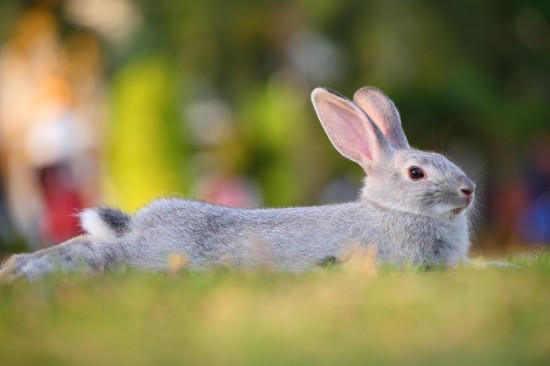

As the temperature rises and summer finally gets started, it's important to pay special attention to the care and wellbeing of your rabbit in order to allow them to enjoy the sunshine with you while keeping their cool. In the wild, rabbits live in an underground network of burrows, which they can use to cool down when it's hot and to regulate their body temperature, as the depth of the burrows within the earth stay naturally cooler than the ambient temperature outside. Domestic rabbits cannot do this, and so your pets will need your help to stay cool as the weather hots up.
Here are some tips on caring for your rabbit during the warmer months of the year.
Unlike people, rabbits do not sweat, and so they cannot moderate their temperature in this way. When it gets hot you will need to provide ways for your rabbits to cool down, particularly when the temperature rises above 25 degrees Celsius, which is approaching the danger zone for rabbits. For rabbits kept outside, make sure that there is a shady area for them to retreat to and if possible, a cooling breeze. If you can set up a fan over your rabbit's hutch or enclosure, all the better.
If you find that some of the rooms of your house are cooler than the temperature outside, and especially if you have air conditioning, try to bring your rabbits inside as this will be more comfortable for them. Going straight from a very hot environment to a cold one can be a shock to your rabbit's system, so don't take them directly from a very hot place into a significantly cooler room- adjust the temperature gradually and remember that in cold air conditioned rooms, your rabbit might find it too cool, even if the temperature outside is baking.
During the early months of the summer, your rabbit will begin to moult, shedding its thick winter coat for a lighter summer version. This is an essential part of your rabbit being able to deal with the summer heat. Of course, moulting and shedding fur means that loose hair will be plentiful, both in your rabbit's hutch and enclosure, and also on their coat itself. Much like cats, rabbits can contract hairballs from grooming themselves and consuming the loose fur, which can harden into a solid lump and cause blockages in the digestive system and intestine. Hair ball obstructions can cause illness, and sometimes even require surgical removal. Grooming and brushing your rabbit regularly can help minimise the risk of them contracting a hair ball, as can cleaning the hutch and removing all loose hair on a daily basis.
Your rabbit will need to drink more water in the summer to keep itself cool, so make sure they have free access to fresh water at all times, and clean and top up their water bottles regularly. Getting enough water is vital to helping your rabbit regulate their body temperature. Placing a couple of cubes of ice in their water bottle can help with cooling, as can feeding treats of frozen peas, carrots and chunks of apple.
Heatstroke is unfortunately all too common in rabbits, as they are delicate creatures who do not deal well with high temperatures. If your rabbit appears limp when you pick him up, listless, unresponsive and half asleep, these are all warning signs of heatstroke and you must act quickly. Heatstroke is an emergency situation for rabbits, and you should not take risks or wait to see if your rabbit will recover on their own. Left untreated, heatstroke can lead to brain damage and sadly, even death. If you suspect your rabbit may be suffering from heatstroke, do not waste any time in getting help. Contact your vet and explain the situation to them- they will tell you to bring the rabbit to the surgery as a priority. In the meantime, cool your rabbit down as much as you can by bringing them out of the heat and sunlight, placing fans near to them, sponging them down with a cool bath, and trying to encourage them to drink water.
Fly strike or Myiasis, to give it its correct name, is sadly all too common a problem for rabbits in the summer, and like heatstroke, can be fatal if left untreated.
Fly strike is mainly caused by the green bottle fly, and occurs when the flies lay their eggs around the anal area of the rabbit or any sores or open wounds. The eggs then hatch into maggots within hours, and literally eat into the rabbit's flesh, releasing toxins and causing the growth of necrotic tissue in the process. The flies which cause fly strike are attracted to the rabbit's scent glands, urine and stools, and the smell of dirty hutches and wet fur, so it is vital to keep both your rabbit and their hutch clean, and remove any droppings and wet bedding on a regular basis.
Also take care not to overfeed, or feed too many fresh greens as this can lead to diarrhoea and excessive amounts of droppings in the hutch, both of which will attract flies. It may also help to place fly screens over the doors of the hutch to minimise access for flies, although this is not a foolproof solution and is no substitute for good animal husbandry and regular cleaning.
During the summer, you will need to make a quick visual check of your rabbit's rear end on a daily basis to check for signs of fly strike- even if the hutch and the rabbit are both scrupulously clean. If you find evidence of fly strike or suspect that a fly has laid eggs on your rabbit, you must take them to a vet immediately as a matter of urgency. Fly strike is an emergency, and it will not clear up on its own.
Copyright © 2005-2016 Pet Information All Rights Reserved
Contact us: www162date@outlook.com